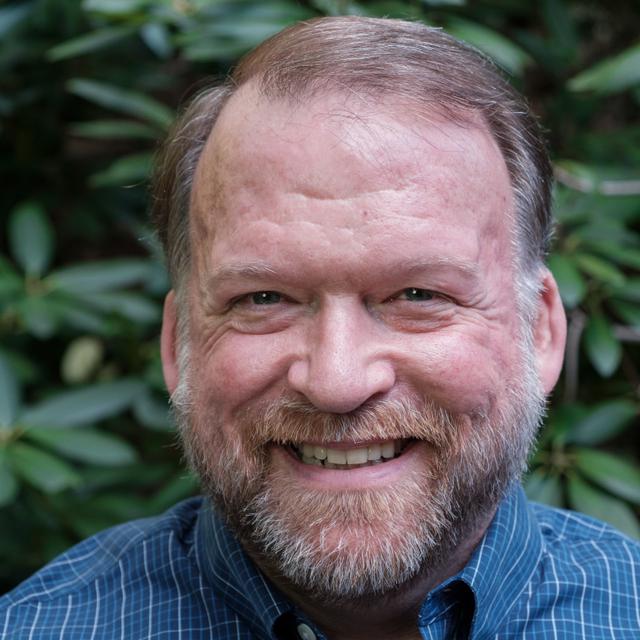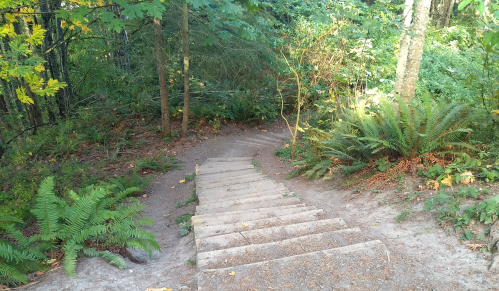Dan Keusal, M.S., LMFT
Jungian Psychotherapy for Individuals & Couples
"Find Your Purpose, Heal Your Pain, Live With Passion"
| Receive my email newsletter! |
Dan Keusal's e-newsletter
Autumn 2019 edition:
"Tree Work Ahead"
(TECH NOTE: Please excuse the errant/extra characters on this page; it is due to a tech glitch in the web design software I've used; for a "clean" PDF copy of this essay, click HERE. To get my newsletters delivered directly to your email inbox,
join my mailing list!)
Greetings...
What if an off-ramp on I-5 proved to be an opening to soul work? That off-ramp, and what I found there, are the starting points for my reflections in this newsletter. In the "Resources" section you'll find a song that poignantly and joyously celebrates life, two books and a poem that may deepen your appreciation for "rooting and reaching," and, a photo that echoes Richard Rohr's assertion that "the path of descent is the path of transformation." As the leaves turn, and days grow shorter and cooler, may you find here something for your own autumn harvest
~Dan
* * * * *
Reflections: “Tree Work Ahead"
There at the entrance to the offramp on northbound I-5 was a large, portable sign whose bright orange letters had been programmed to flash the words: “Tree Work Ahead.”
For a few moments, I imagined what kind of work was being done on behalf of these trees: tending them, nurturing them, pruning their branches to keep them healthy, spreading fresh, organic mulch around the base of their trunks, or even adding to their numbers through plantings.
I went into reverie and brought to mind some of the trees that have enriched my life…
Just beyond a west-facing window in my home, there is a bank of trees that has watched over me for a quarter-century as I’ve sat at my desk each day—writing, working, and dreaming. I’ve been soothed by the sound of the wind gently blowing through the leaves and needles of these trees, and by the birdsong coming from their branches. I’ve seen them thrashed by rain, and I’ve been quieted by the grace of their snow-laden boughs. Those trees have also helped mark the larger rhythms of the seasons. Year after year, on the summer solstice, the sun sets behind the Cedar far to my right in the north; on the spring and autumn equinoxes, it sets behind the Lombardy Poplars directly in front of me, due west; and on the winter solstice, it sets low in the sky, behind the Douglass Fir that is far to my left in the south. These trees have become an integral part of my home; my daily life would be diminished without their presence. So I was alarmed and grieved when word reached me that local authorities were planning to cut down the Poplars, fearing they might be a threat to nearby property; as best as I can tell, those fears have been quelled and those plans have been put on hold, but in the meantime my daily communing with those Poplars has become even more dear.
I was shaken from my reverie when I pulled to a stop at the traffic light just beyond the end of the off-ramp. Something was different. Something was off. Something was missing. It was then that I began to realize what “Tree Work Ahead” actually meant.
All of the trees that had once risen above the other side of that intersection were gone. I turned left at the light, found a place to park on the other side of the bridge that stretches across I-5, and walked back to take a closer look.* What I saw was a stretch of land littered with tree stumps and debris, being cleared by a backhoe and dump truck. All the trees along this bank of land reaching up from I-5 had been cut down in preparation for construction of the new light rail extension, slated to stretch from Northgate to Shoreline and eventually on up to Lynnwood.
Set as they were alongside the rushing traffic of an interstate highway, these were probably not anyone’s personally cherished trees. It’s unlikely that anyone leaned against them reading a book, or carved a heart around two sets of initials into their bark, or shared a picnic in the cool of their shade. They were, perhaps, noticed only in their absence, echoing Joni Mitchell’s classic lyrics:
Don't it always seem to go
That you don't know what you've got
Till it's gone
They paved paradise
And put up a parking lot
Or a light rail station.
One could reasonably make the point that public transportation is a good that warrants cutting down some trees, a good that facilitates connection and community and may even help the environment: more people riding in trains rather than cars means less exhaust, and that means better health for the people and less work for the trees that remain.
But what about when choices like trains over trees become a constant, unconscious, indiscriminate pattern? When some things are consistently deemed more important than others?
Trees are present, living things, and they are ancient, archetypal symbols. They play an essential role in the outer environment and in our psychological and spiritual well-being. Trees show us the value of rootedness and of reaching. They remind us to reach down—into the earth, and into the unconscious—to draw up the essential nutrients we need in order to thrive and grow. The remind us to reach up toward the light, to engage in a kind of photosynthesis that transforms the carbon dioxide from our daily grind into life-giving oxygen that fuels our next endeavors. And trees offer us an aesthetic and a presence with nutrients nearly as essential as oxygen itself.
Trees also offer us perspective, bearing witness to a sense of time that transcends and informs our day-to-day existence. There is a bristlecone pine in California that at 4,851 years old may be the oldest living thing on earth. What kind of wisdom might we receive from that tree, if only we knew how to listen? As Herman Hesse once wrote “Trees do not preach learning and precepts. They preach, undeterred by particulars, the ancient law of life.”
I imagine that there will be some sort of civic celebration when the new light rail stations are complete—another instance of the proverbial ribbon-cutting ceremony. But what if a different kind of ceremony had preceded that one?
What if, before the first chain saw was fired up, before the first backhoe or dump truck arrived on the scene, there was a ceremony to celebrate those trees and all they had given? To honor the sacrifice they were about to make, and to mourn their passing? What if this gathering was deemed important enough to merit the presence of the same civic officials who would later cut the ribbon? What if those officials had the wisdom to forgo the photo-op and instead yield the stage to the community’s elders and spiritual leaders? What if stories were then told of these trees? What if prayers were prayed, and songs were sung? Perhaps then, in the future, both the people on the trains and the land over which those trains traversed would be more healed, more whole, more at peace.
On a recent visit to the Royal BC Museum in Victoria, in an exhibit showcasing the customs, codes, and laws of First Nations people, I came upon these words: “Our lives, our culture and our continued existence as a people are completely tied to the land…We are taught to respect everyone’s way of life. Share our land, yes. But never give it away…Every creature in the universe and every person in society has a rightful and meaningful role to play…We need each other, and must learn from our mistakes.”
We do, indeed, have “tree work ahead.” It is both outer work and inner work. It is the work of learning to balance our desire for progress, speed, and convenience with the wisdom to live in accord with all the other living things on this planet. It is the work of learning to see and understand the archetypal symbols that take us deep into our own psyches, and then call us up and out again to engage life it all of its richness, complexity, and mystery. May each of us in our own way be steadfast in our commitment to this work.
*A colleague stopped me in the halls of my office a week later, saying “I thought I saw you last week, on the bridge over I-5, taking pictures…” Here is one of those pictures.
Resources For A Life Of Depth And Meaning:
(song): "Beyond The Cedar Moon" (Craig Olson). For lyrics, click here. For more on Craig Olson and his music, click here.
(book): Like A Tree: How Trees, Women, and Tree People Can Save The Planet (Jean Shinoda Bolen)
(book): The Hidden Life of Trees (Peter Wohlleben).
(poem): "The Sycamore" (Wendell Berry)
(photo): "Descent" (Dan Keusal). Click on the photo to download a copy for your own enjoyment.
Dan Keusal, M.S., LMFT, Psychotherapist. (206) 523-1340. Email: dankeusal@dankeusal.com

